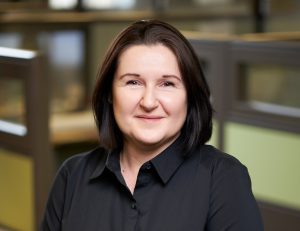Posen People: Meet Renata Mayhew

Renata Mayhew, AIA, is the Director of Healthcare, guiding projects to ensure they meet the unique requirements needed for healthcare spaces. This may include concerns such as whether a control area is close enough to an MRI screening room or making sure surfaces are durable and easily cleanable. Renata works closely with other team members in facilitating each client’s needs into highly functional, aesthetically pleasing finished projects.
Read below to learn more about Renata’s background and approach to design.
Tell us a little more about your role at Posen Architects, LLC.
I work mostly on medical projects. Healthcare settings have different, more rigorous code and space requirements than retail or office spaces. The space plan as well as the products and materials we use are based on each medical subspecialty. Frequently, they must also meet state health department requirements. I collaborate with our clients, consultants and project team to address these types of details.
Who or what inspired you to be an architect?
I grew up in Poland and was always fascinated with how buildings could be self-reliant.
A well and septic system could make them almost self-sufficient, and I dreamt of the day buildings also could be off the electrical grid as well. At the same time, I saw how buildings built across Europe have stood for hundreds of years and I wanted to learn how to make structures that durable.
How are you translating this inspiration into designs for the future?
For instance, look at all the flooding that has occurred across the country. So many structures have been completely destroyed. By incorporating new technologies, we can create resilient buildings that can survive today’s severe weather. I want to approach projects with this perspective whenever possible.
What do you love most about your career?
Being able to see a sketch turn into reality. When someone draws a cartoon character, the finished product is still just a drawing. But when you draw a sketch and it becomes three-dimensional, an actual building, it’s very rewarding to experience that process.
What has surprised you most in your work?
The versality of materials and variety of products and how they evolve. Years ago, a light fixture just provided light. Now, we can program lights to change colors (?) during a day/night cycle, or even seasonally, which can help patients feel like they’re more connected to the outside world. There are also panels that are transparent windows able to become opaque with the touch of a hand. It’s pretty amazing.
Has the industry changed since you started your career, and if so, how?
I started working with an architect who was in his 60s and never used a computer. Today, software is so detail oriented that any input can affect the entire project. Also, we now deliver projects differently. We sit down together – the client, architect, engineer and contractor– at the beginning of the project, as opposed to meeting contractors at the bid process. Having early input on cost and schedule helps make the whole project more successful.
If someone is considering a career as an architect, what would you tell them?
It’s not an easy career, it took me quite a while to get to a position of leadership. But if you are really motivated to design buildings, it’s well worth all the hard work that is required.
You said it took you quite a while to become an architect. Can you tell us a little about your journey?
College is free in Poland but about 60 people apply for every spot, so you must know at a young age what you want to do. After going to a technical high school, I pursued a civil engineering degree. In the United States, I had to go back to college because the requirements are so different. I thought hard about what I wanted to do and knew my desire to design was more aligned with architecture.
What is one of the main characteristics you believe is necessary to be a successful architect?
Being detail oriented and if you are able to see 3-dimensional structures in your mind, how things fit together, that is a tremendous asset.
What makes Posen Architects different than other firms?
We’re a tight group of professionals who work together to solve problems and move each project along. We help each other through every step until we’ve brought the client’s vision to completion.